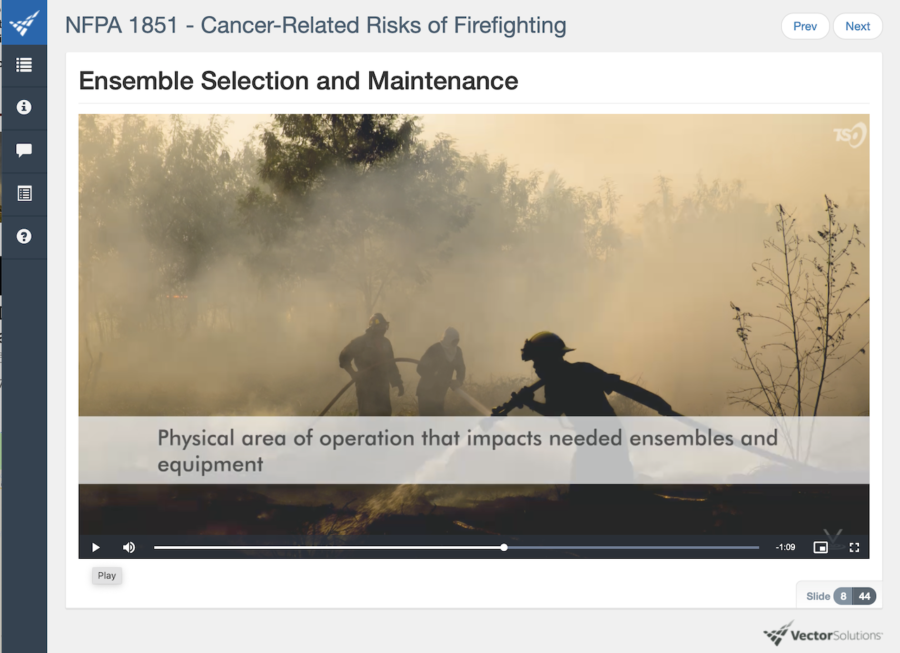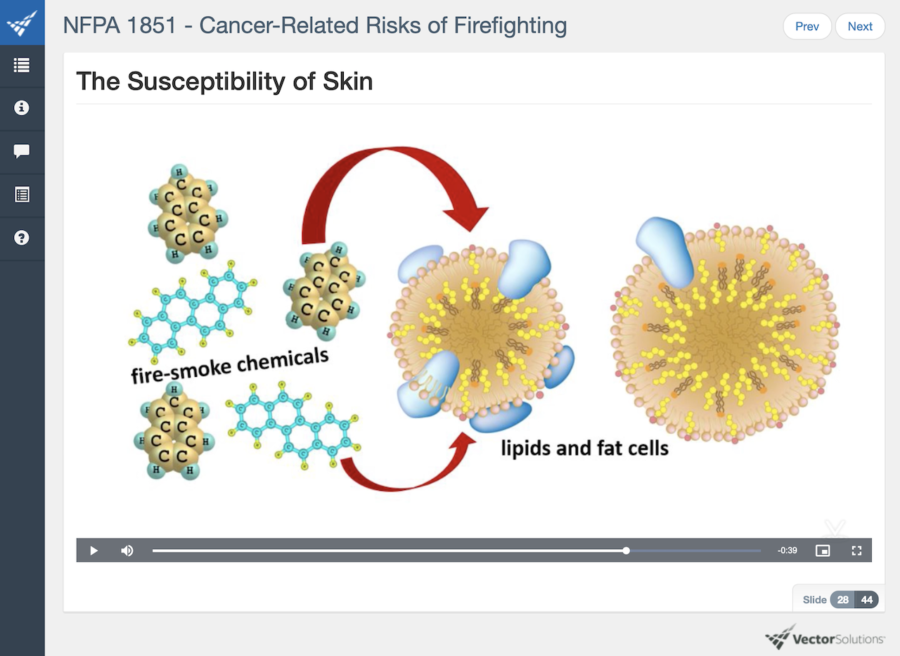
For the past day or so I’ve been dropping into a cancer awareness training video hosted by Vector Solutions. I was recruited in part by Vector’s pledge to donate to the Firefighter Cancer Support Network for every completed course. About halfway through the two-hour course, guided by NFPA 1851’s “Cancer-Related Risks of Firefighting,” I paused the screen, as I have many times, this time at the list of cancers linked to firefighting … and typed out the systemic locations and types of cancers … genitourinary, kidney, testicular, brain, head and neck, non-Hodgkins lymphoma, thyroid, and — as the narrator notes — “skin cancer, especially in wildland firefighters.”
After that I stopped taking breaks, following the chapters that explored the risks and protective actions we can take against them — all the time noting that while fire is fire, NFPA 1851 is by definition a standard focused on “Selection, Care, and Maintenance of Protective Ensembles for Structural Fire Fighting and Proximity Fire Fighting.” While many in the field are cross-qualified in structure and wildland firefighting, of equal concern — whether we’re responding in turnouts or wildland PPE — is that many key cancer risks are shared across the structural and wildland communities.
For instance, there is the caution in this training against skin exposure. While those in wildland fire are so often cautioned to protect our airways, the skin exposure to airborne carcinogens and char can be significant in wildland firefighting. The training notes the formidable cocktail of chemicals released in structural fire suppression — and though the vectors and hazards are different, take a moment to compare the protective components of turnouts and SCBAs to wildland Nomex and bandanas. And as the training notes, “For every 5 degrees F increase in skin temperature, there is a 400% increase in the absorption capability of our skin.” And exposed skin is a conduit for carcinogens to bioaccumulate in fat cells and lipids.

To explore the connections between cancer and firefighting, Vector Solutions connected us with Chief Todd LeDuc (@ToddJLeDuc), retired from Broward County Fire Rescue, board member for the International Association of Fire Chief’s (IAFC) Safety Health & Survival Section, and editor of “Surviving the Fire Service.” We’ll have more from our conversation with Chief LeDuc in upcoming posts, but what’s key for now is the importance of awareness noted by LeDuc. Firefighters — structural and wildland — face increased cancer risk, and we should prioritize early detection and treatment while integrating immediate risk reduction. Leduc’s core advice for structural and wildland firefighters?”Get the carcinogen off the body as soon as we can.” He shared the concept to “Shower within an hour” after exposure to clean carcinogens from skin exposed to smoke — or more immediately (and more timely and feasible in wildfire work) is to use wet wipes to clean off during a break.
Another shared yet often hidden fire-service carcinogen is diesel exhaust, a Group 1 carcinogen (as is benzene). As the training notes, the state of California states that “diesel exhaust provides the highest cancer risk of any contaminate.” And as the narrator notes, diesel exhaust is “A real threat that is by and largely preventable, but for the cost” — the cost being that of pollution-trapping entrainment systems or finding alternative fuels and procedures for heavy-engines and generators.
And don’t forget to think of the impacts of 24-hour shift work has on our overall health, including an increased risk of cancer.
We will share additional posts during Firefighter Cancer Awareness Month, but in the meantime you might put aside two hours for the training. Complete the test (I passed at 80%) and “$1 will be donated [by Vector Solutions] to the American Cancer Society and Firefighter Cancer Support Network for each completed course.” Complete the PTSD course for another donation — and consider a matching donation to support firefighter safety in 2023.
LINKS
- “Free Training for Firefighter Cancer Awareness Month.” Vector Solutions. https://media.vectorsolutions.com/media/TSC/emails/ps-fire-firefighter-cancer-awareness-2022-12.html
- “Firefighter Cancer Awareness Month.” Firefighter Cancer Support Network. https://firefightercancersupport.org/firefighter-cancer-awareness-month/about-cancer-awareness-month/

Shower within an hour? ROFL. When are we going to see H pay for prescribed fire? A controlled fire is just as toxic as an uncontrolled fire. Carcinogens are carcinogens.